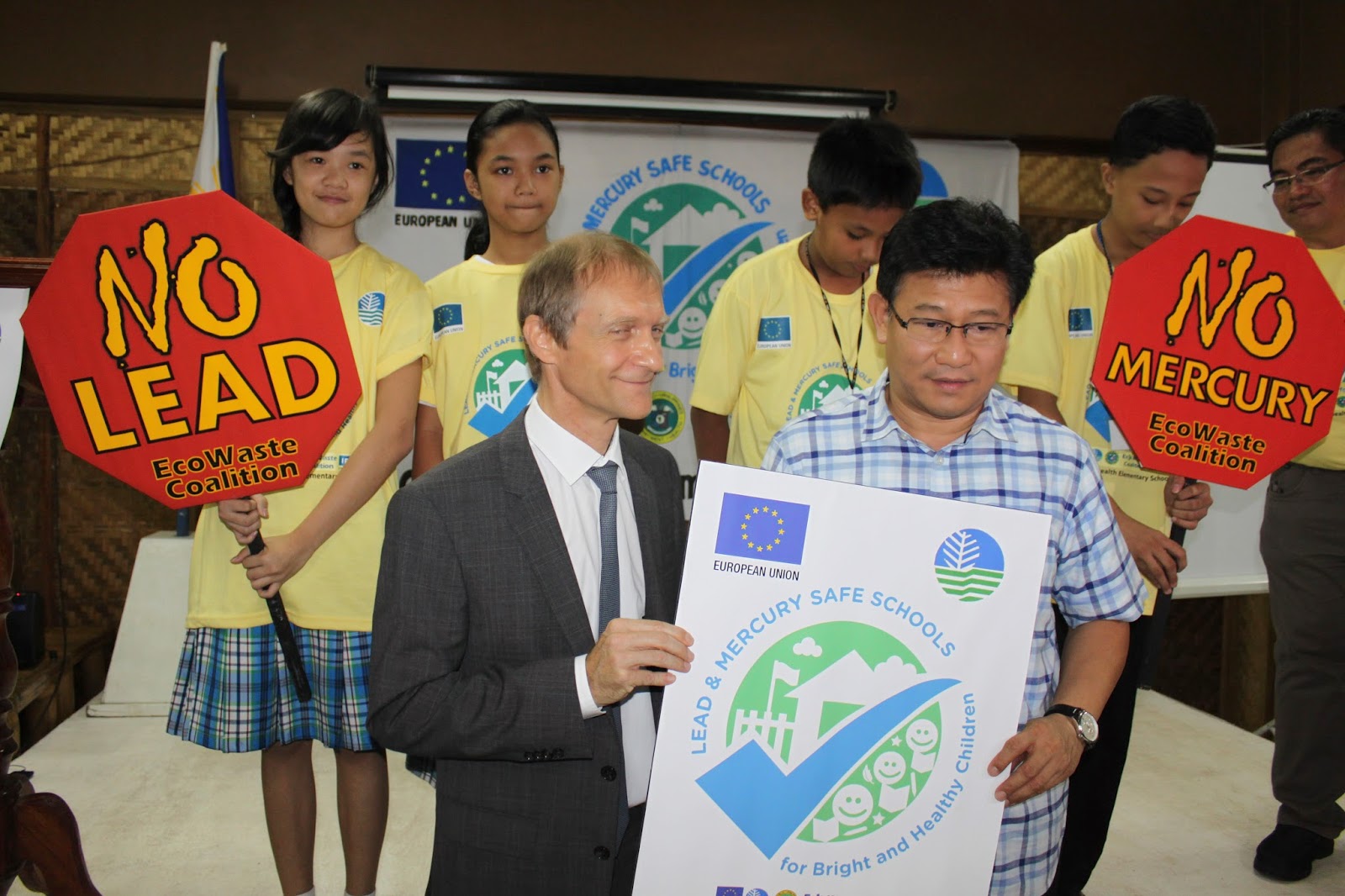DENR Secretary and EU Ambassador Advocate a Lead-Free Philippines!
Photos by Chris Evangelista
24 June 2014, Quezon City. The government of the Philippines and the European Union have joined hands to protect school children from chemicals known to have serious toxic effects on the brain.
During a school visit organized by the Department of Environment and Natural Resources (DENR) and the European Union (EU), Environment Sec. Ramon J.P. Paje and EU Ambassador Guy Ledoux signed a Solidarity Statement and led stakeholders in pushing for “Lead and Mercury Safe Schools for Bright and Healthy Children.”
Lead and mercury are highly toxic chemicals known for causing lifelong and irreversible damage to a child’s brain and health even at low levels of exposure. Childhood exposure to lead, in particular, has been blamed for reduced intelligence as measured by decreased IQ points, prompting health experts to recognize “lead caused mental retardation” as a disease. 600,000 new cases of children with intellectual disabilities due to lead exposure occur worldwide every year according to the World Health Organization.[i]
The event took place at the Commonwealth Elementary School (Commonwealth Ave., Quezon City)—regional winner for the DENR’s Search for Sustainable and Eco-Friendly Schools. Secretary Paje and Ambassador Ledoux were accompanied by senior officials from the Department of Education, as well as 200 kids, parents, local government officials, doctors, paint manufacturers and environmentalists.
Sec. Paje led the
signing of a “Solidarity Statement” to signify stakeholders’ agreement
to promote and uphold “Lead and Mercury Safe Schools,’ specifically “by using
lead safe paints and safely reducing lead paint hazards to contain and minimize
hazardous dust, and by switching to mercury-free alternatives towards a
toxics-free, zero waste educational system.”
The event drew special attention to the Chemical Control Order (CCO) for lead and lead compounds recently promulgated by the DENR that sets 90 parts per million as total lead content limit for lead in paints, as well as prohibits the use of lead in the manufacture of beverage and food packaging, school supplies and toys.[ii]
“We want to enable our paint industry to shift to lead-free production. There is now a global action for the elimination of lead in paints, and certainly this CCO is our way of showing our oneness with this advocacy,” stated Sec. Paje.
“Chemical safety and security must be a
priority of the schools. May this undertaking
inspire more schools to commit towards lead and mercury-safe school
environments for Filipino children,” he added.
Ambassador Ledoux congratulated the DENR
for issuing the CCO, emphasizing that “the country’s ongoing switch to non-lead
paint production is key to protecting the health of children and other
vulnerable populations from the debilitating effects of lead exposure.” “A
school environment that is safe from lead and other harmful chemicals will have
a positive impact on children’s health and their potential to grow, develop and
succeed in life,” the EU Ambassador said.
The European Union supports the Asian
Lead Paint Elimination Project to eliminate lead in paint and raise public
awareness about the adverse human health impacts of lead-based decorative
paints, particularly on the health of children below the age of six. The
project is a PHP 80 Million grant implemented in seven Asian countries. The
EcoWaste Coalition is the leading project partner in the Philippines.
For her part, Aileen Lucero, National
Coordinator of the EcoWaste Coalition, said: “We hope DepEd can make it
mandatory for all schools to require only lead safe paints for paint purchases
and donations. This will effectively
curb children’s exposure to leaded paint chip and dust and bring about improved
IQ, enhanced school performance and economic success later in life.”
Lucero cited a recent scientific study that calculated the economic impact of childhood lead exposure in low and middle-income countries at PHP 42 trillion per year. The Philippines ranked second highest in Asia in terms of economic loss due to reduced economic productivity resulting from lead exposure.[iii]
During the event, the stakeholders also recognized the other efforts of the government to address the problems with lead and mercury such as the phaseout of mercury in medical devices in all healthcare facilities and institutions, the ban on consumer products with violative levels of lead and mercury, and the signing of the Minamata Convention on Mercury and the ensuing effort to get the treaty ratified.
-end-
More explanations about lead exposure
through lead in paint:
Children are not generally exposed to
lead from paint while the paint is still in the can or even when the paint is
being newly applied to a previously unpainted or uncoated surface. Rather, the
lead exposure generally occurs after the lead paint has already dried on the
wall or on the article that has been painted.
Painted surfaces deteriorate with time
or when disturbed, and lead from the paint then contaminates household dust and
soils surrounding the home. Children can then ingest lead from dusts and soils
during customary hand-to-mouth behavior, after which neurological damage
occurs.
















Comments